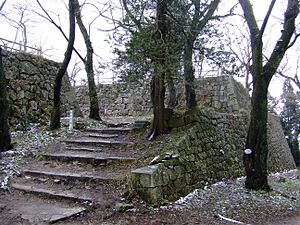Murakami Castle
| Murakami Castle | ||
|---|---|---|
|
Murakami Castle, ascent |
||
| Creation time : | around 1500 | |
| Castle type : | Hirayamajiro (hill castle) | |
| Conservation status: | Walls and ditches exist | |
| Place: | Murakami | |
| Geographical location | 38 ° 13 '11.5 " N , 139 ° 29' 6" E | |
|
|
||
The castle Murakami ( Japanese 村上城 , Murakami-jō ) is located in the city of Murakami in Niigata Prefecture . In the Edo period , a branch of the Naitō resided there as a Fudai daimyō .
Lords of the castle in the Edo period
- From 1616 the Hori with an income of 100,000 Koku ,
- from 1644 a branch of the Honda with 100,000 Koku,
- from 1649 a branch of the Matsudaira with 150,000 koku,
- from 1667 the Sakakibara with 150,000 Koku,
- from 1704 a branch of the Honda with 150,000 Koku,
- from 1710 a branch of Ōkōchi with 72,000 koku,
- from 1717 the manabe with 50,000 koku,
- from 1720 a branch of Naitō with 50,000 Koku.
history
Murakami Castle is said to go back to the Honjō ( 本 庄 氏 ). It is located on the hill Gagyū-zan ( 臥牛山 ) 103 m above sea level, an extension of a ridge running from northeast to southwest.
When Hori Hideharu ( 堀 秀 治 ; 1576-1606) received the province of Echigo in 1598 , he gave the castle to his vassal Murakami Yorikatsu ( 村上 頼 勝 ) with an income of 90,000 koku . Yorikatsu expanded the castle with walls and eight watchtowers and built a castle town below the hill. In 1618 Hori Naoyori ( 堀 直 寄 ; 1577–1639) moved in with 100,000 koku. Other lords followed, until finally a branch of the Naitō took over the castle until the Meiji Restoration in 1868.
The attachment
The Hori formed the castle further with the innermost area, the Hommaru ( 本 丸 ; 1) with the castle tower ( 天 守 , Tenshu ; marked in red), and the other areas Ni-no-maru (二 の 丸; 2) and San-no-maru (三 の 丸; 3) on the top and lengthened the walls. From 1661 Matsudaira Naonori ( 松 平 直 矩 ; 1642–1695) continued to build the castle with the permission of Bakufu and in 1663 built a three-story castle tower, which was lost in 1667. After that, the castle tower was not rebuilt.
At that time the residence [R] was laid out at the foot of the mountain, and the buildings for the keeping of the Han were added there . In 1752 the watchtower of Kane-no-maru ( 鐘 の 丸 ) burned down due to a lightning strike . In 1752 the gate Naka-no-mon ( 中 の 門 ) was lost by a lightning strike. In 1778 large areas of the castle were lost, this time in a fire.
In the Boshin War of 1868 the castle was attacked by the troops of the new government, whereupon the soldiers of the Han set the second part of the castle on fire. The remaining structures were demolished after 1868.
Today the base of the castle tower on the southwest corner of the Hommaru is still preserved, and the stone remains of the gate to the Hommaru can also be seen. In the second area of the castle, the bases of buildings placed on the walls, so-called Yaguratamon ( 櫓 多 聞 ), can be seen, and the remains of four gates have been preserved. The third castle area has been preserved to a similar extent.
Remarks
- ↑ Literally: "The stretching bull", a frequently occurring mountain term in Japan.
literature
- Ikeda, Koichi: Murakami-jo in: Miura, Masayuki (Ed.): Shiro to jinya. Tokoku-hen. Gakken, 2006. ISBN 978-4-05-604378-5 , p. 145.


